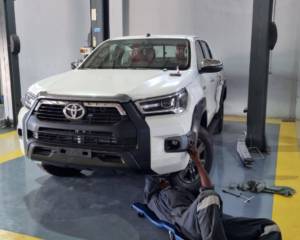
A good maintenance culture saves costs in the long term and increases the life span of a vehicle. Most fatal accidents and sudden breakdowns that people experience could have been prevented if only they knew critical things to check in their cars daily before driving. Proper daily inspection of your vehicle will help in identifying and resolving underlying issues as they occur. Inspecting your cars regularly is vital for a safe journey!
The following are 10 key steps to effectively ensure your vehicle is safe for a drive:
1. Fluids (oil and coolant)

Ensure they are kept at appropriate levels, to keep your car running smoothly. Driving low on engine oil and other fluids can lead to engine problems, always check the engine oil level with a dipstick.
2. Leakages
After checking the oil and fluid levels. It’s also a good practice to ensure that there are no leakages by checking under the vehicle before you drive. If a liquid or oily substance is spotted, it is most likely a leak that needs to be traced and stopped to avoid damage to a key component of the vehicle.
3. Brake pads
Your brake pads require regular inspection, habitually checking on your brake pad is vital to your safety, and this should be replaced immediately it gets worn out or after a fault is observed. Always pay attention to vibrations or noise from the brake pads and instantly consult your mechanic to fix it.
4. Brakes
This is one vital thing that can only be tested when the car is in motion. It is crucial to ensure the brakes have the necessary stopping power once you step into your vehicle. If you notice that it’s not functioning properly, consult your mechanic immediately.
5. Lights
There should be careful checks on your lights, these include the headlights, fog lights, reverse lights, and all other lights in your car. Each of these lights was designed to send a message to other road users to either let them know what you are doing or what you intend to do. For instance, brake lights inform others that you are slowing down or coming to a halt. Hence, driving without your lights or a dim light at night can be very risky. Driving without headlights is also an illegal act because it’s possible to not be seen early by other drivers at night which can lead to fatal accidents.
6. Wiper Blades
This is your best friend on a rainy day or when driving in a dusty environment. The wiper blade removes any form of liquid or dirt from the windshield that might impair your vision, giving you a clear view of the road. Always check your wiper blade is in good condition, a good wiper blade is inexpensive for your safety.
7. Horn
The purpose of the horn is to warn those around your car while approaching them or to draw attention to some hazard. Pay attention to possible weak sounds when you press your horn and have it fixed or replaced as soon as possible.
8. Tyres
This is a simple check, inspect the tire gauge. The tire can quickly become deflated if they are punctured. This can result in uneven wearing of the tread. Deflated tires can also increase rolling resistance.
8. Spare Tyre and other tools
These items can be found in the trunk of a vehicle. Ensure that your triangle, wheel spanner, jack, wedges, fire extinguisher, etc. are all intact and you know exactly how to use them. They all have different purposes and they can save you in an emergency situation.
9. Documents
Frequently check for your car documents (driver’s license, proof of ownership, Insurance certificate, certificate of roadworthiness, certificate of vehicle registration). Ensure your documents are up-to-date to avoid fines, delays, and vehicle confiscation.

